Impregnation waterproofing - (penetrating) is carried out by impregnation of building products made of porous materials - concrete plates and blocks, asbestos-cement sheets and pipes, limestone and tuff blocks with special materials. Penetrating materials are made from cement with additives of chemically active substances and specially crushed sand. It is used mainly for internal waterproofing of foundations and basements, as well as for the repair of concrete structures.
This material can be used in both reconstruction and new construction, if access to external surfaces is limited, and the only way to install waterproofing is from inside the building.
The crystalline formations of the waterproofing mixture penetrate into the pores of the concrete to a depth of 60 cm and become an integral part of the concrete, guaranteeing its impermeability.
The pluses include the fact that during operation, upon contact with water, the chemical reaction continues, and the sealing process continues - concrete self-healing occurs. It turns out a double waterproofing effect: waterproofing the outer layer and crystallization of the pores inside the concrete. In addition, when using this technology, the walls remain vapor-permeable.
Thickness of the waterproofing layer: from 1 to 3 mm. Material consumption: from 0.8 kg/m2 Water resistance: withstands pressure of 0.8 MPa.
Features of impregnating waterproofing:
Can also be applied to damp surfaces.
You can work without exposing the outer walls.
Possibility of waterproofing after completion of the main construction works.
Does not require protection during backfilling, rebar placement, etc.
Does not require pre-treatment of the surface with a primer.
Increases the frost resistance of concrete, protects it from weathering and other damage caused by weather conditions.
High chemical resistance (pH between 3 and 11)
Provides protection against corrosion - prevents oxidation of fittings.
The decision to use one or another type of impregnating insulation is made when creating a project and coordinating it with the builders.
Cons: Penetrating waterproofing is more suitable for fresh concrete. When repairing old concrete, it is necessary to clean the surface of plaster and degrease in order to open access to the capillary system of the surface. To do this, you will need a shot blasting or water blasting machine operating at a pressure of at least 15-20 atm, since the use of a scraper or a wire brush will not be enough.
To protect concrete surfaces from moisture, many varieties of waterproofing coatings have been developed today. Materials can be:
- painting;
- pasting;
- coating;
- penetrating.
But if the goal of protecting concrete structures was set at the construction stage, then such work can be carried out not only from the outside, but also from the inside. This task can be dealt with by applying a waterproofing layer or by adding special substances to the solution. Which materials are better to use, you can understand if you read the information below.
Adhesive and coating materials for concrete waterproofing
Concrete waterproofing can be carried out with adhesive or coating materials. They are made from polymers. Before applying the waterproofing layer, it is necessary to level the surface, and as a result, it will be possible to obtain a dense and durable film that has water-repellent qualities. But these materials have one important drawback, it is expressed in the fact that over time the layer begins to move away from the surface, eventually leaks form, dictating the need for repairs.
Roll waterproofing of concrete using bituminous materials by type of roofing material is cheap, but also has disadvantages. If a concrete floor is waterproofed using this technology, then you should additionally stock up on a gasoline or gas burner, with the help of one of which you will need to heat up and glue the layers together. This creates inconvenience, which is especially true for small rooms.
Among other things, during the heating process, an unpleasant odor and smoke are released. If the waterproofing of concrete will be carried out with the help of roofing material, then after its laying it is necessary to equip an additional layer of screed, which will certainly reduce the height of the ceilings, creating a load on the foundation.
Penetrating waterproofing

To eliminate the problems that were described above, you can use penetrating insulation. It looks like a mixture of chemically active additives, quartz sand and cement. Such a composition is applied to the surface, which ensures the filling of small pores, voids and microcracks. As a result, it is possible to form a monolithic surface, which has high strength characteristics. If you use this method in rooms with high humidity, then you must additionally use sealants and water-repellent mastics.
Classification of penetrating insulation for concrete
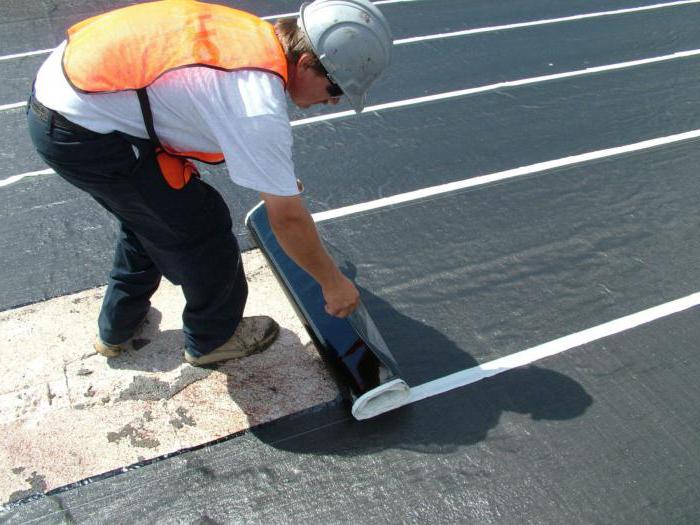
Penetrating concrete waterproofing can be:
- concreting;
- polymer cement;
- cement.
The first variety is frost-resistant, has a high density and strength. Concrete penetrating waterproofing can be used as an additive for mixing mortar for waterproof high-strength structures, resulting in high quality products.
It is also possible to use similar compositions to create a protective reinforcing layer. Polymer-cement waterproofing has good adhesion to the material and has high strength. This tool can be used to treat concrete, brick and wood surfaces.
The technology is environmentally friendly and quite easy to use. Application can be carried out on wet or dry surfaces. Cement inorganic concrete waterproofing can be used for wall and floor treatment. This is very convenient for those rooms whose conditions are characterized by high humidity, among them:
- bathrooms;
- laundries;
- pools.
The main advantage of the materials is that ceramic tiles can be laid on them.
Seamless waterproofing

This technique is also called liquid film. It uses materials suitable for the treatment of all surfaces in bathrooms, kitchens, toilets and rooms where treatment of areas with high humidity is required. The product can be applied with a spatula, roller or brush.
Initially, the joints between the walls and floor slabs are processed, after which the mixture is applied to the floor surface, and a waterproofing tape is needed, which is pressed into the mixture with a roller or manually. In those places where there are drains, it is necessary to install waterproofing cuffs. Then the agent is applied again. The layer should be uniform, it is important to exclude gaps. The composition should go on the wall by 35 cm. It should be left for 2 hours in natural drying conditions. Then the surface is treated again and dried for 12 hours. If the work is done according to the rules, then problems with fungus and dampness should not arise.
Using bituminous mastic for waterproofing

Waterproofing of the concrete surface can be carried out using bituminous mastic. This material is quite popular due to a number of positive characteristics, among them are:
- elasticity;
- availability;
- ease of application;
- wide area of use.
Mastic has the quality of elasticity. It is expressed in the ability to compress and stretch. By using this material it is possible to create a high level of adhesion of the base to the coating. The dried layer does not tear when exposed to high temperatures, does not form cracks and copes well with changes in the size of the base.
If you are looking for a compromise between quality and price, then you should cast aside doubts and choose bituminous mastic, because it has high quality and is inexpensive. As a result of its application, it is possible to obtain a reliable and durable coating. There is no need to use professional equipment to apply the material. And not only concrete surfaces, but also brick, metal, and also wooden.
Varieties of bituminous mastics and features of their use

If you will be waterproofing concrete, it is important to consider materials for such work. Among others, bituminous mastic should be distinguished. To create a high-quality coating, you need to bring the composition to a state of minimum viscosity, this can be done in several ways:
- mixing with solvents;
- heating;
- emulsification in water.
Bituminous mastic is a composition that is made on the basis of the material of the same name with the addition of additives, namely:
- antiseptics;
- modifiers;
- plasticizers.
Bituminous mastic can be used to perform repairs or in the construction area. It is also good because it is suitable for waterproofing measures on surfaces of complex shape, which have transitions and junctions. In the cases mentioned, mastic is the only right solution that allows you to achieve a good result. On sale you can find several varieties of mastics. The hot composition has oxidized bitumen and fillers of mineral origin among the ingredients. Before using this mixture, the material should be heated so that it becomes ductile.
The application is carried out in hot form, during the cooling process a seamless, even coating is formed, which is inaccessible to water penetration. You can choose to waterproof with bituminous cold mastics. They can be water-based or solvent-based. In the latter case, we are talking about a mixture that has organic solvents in the composition. After applying the material, they evaporate, and the concrete forms a coating that reliably waterproofs the surface. Shrinkage at the time of drying is a feature of this waterproofing. The degree of shrinkage will depend on the amount of solvent. It is not necessary to warm up such waterproofing, and a brush or roller can be used for application.
bituminous emulsion
Another name for water-based mastic is bituminous emulsion. For the preparation of the composition, polymer modifiers and emulsifiers are used. Bitumen can be contained in waterproofing in the amount of 20 to 70%. This concrete waterproofing mix is non-toxic, odorless, can be applied to wet surfaces and has a short drying time.
Additives for concrete waterproofing

Today, additives in concrete for waterproofing are quite common. They improve the quality of the designs. The amount of cement can be reduced, while the brand remains unchanged. The most effective are additives for obtaining high grades of concrete, among them it is worth highlighting:
- superplasticizers;
- waterproofing additives.
Additional features of additives
The action of the described additives is aimed at increasing the water resistance of the material by reducing porosity. The substance fills the capillaries and voids, seals the structure. Sealing additives are most often found in the composition of polymers. They are able to increase water resistance to W8W12 level. This goal can be achieved with the help of superplasticizers and plasticizers. They make concrete more fluid, and air bubbles freely rise to the top, resulting in reduced porosity.
Modern solution
Crystal-forming hydrotechnical and penetrating additives in concrete for waterproofing are more modern. With their help, it is possible to achieve the formation of crystals in pores and capillaries. The substance that fills the structure of concrete does not dissolve in water. If, after the concrete has hardened, water enters it, then the substances begin to swell and fill the voids.
As a result, even small cracks are repaired independently. This method of waterproofing is quite expensive. But if the concrete has a high density, then the method is not suitable. With the help of hydraulic additives, it is possible to increase the water resistance to a level within W18-W20. These compositions are actively used in the creation of concrete monolithic foundations, water tanks and pools.
Liquid waterproofing
Liquid waterproofing for concrete is offered for sale in several varieties. Among others, liquid rubber should be distinguished, which is sprayed onto the surface of the structure. After drying, it remains elastic, and when the soil moves and the house shrinks, the waterproofing remains intact. It stretches where cracks form.
Liquid waterproofing for concrete is applied to a dry surface. It is susceptible to ultraviolet radiation, and given that its color is black, the coating will attract maximum sunlight. The rubber surface of the aerial part of the foundation must be hidden under the finish or painted in light colors.
Liquid glass
Today, liquid glass is often added to concrete for waterproofing, while it is important to observe the proportions. The volume of material should not exceed 10% of the total mass of the solution. If we are talking about industrial scale, then 72 liters are added per cubic meter, which is 7%. This allows you to create material with the best technical specifications. If you intend to prepare concrete at home, then you should follow the proportion of 1 to 10.
Waterproofing "Penetron"
Penetrating waterproofing for concrete "Penetron" is a dry mixture of special cement, active chemical additives and quartz sand. "Penetron" is used for monolithic and prefabricated reinforced concrete and concrete structures. With the help of the solution, you can increase the indicators of water resistance, frost resistance and strength. The material perfectly protects the structure from the effects of the following aggressive environments:
- alkalis;
- acids;
- sea water;
- groundwater and wastewater.
Internal penetrating waterproofing brand "Lakhta"
Internal waterproofing of concrete can be carried out using a product under the Lakhta brand. A substance is used to prevent leakage of liquid under positive and negative water pressure. The composition is represented by a dry mix based on cement using high-quality sand and chemical additives. Lakhta penetrates into the concrete structure by 12 mm.
After preparing the solution, it must be used within half an hour. The working ambient temperature varies from +5-35 °С. This internal waterproofing concrete is applied to the open pores of the material. To do this, the surface is pre-cleaned of dirt, dust and cement film.
4244
Hydraulic isolation of concrete with special compounds is important in the construction of new buildings, and the preservation of existing ones. With proper treatment of old foundations with protective materials from dampness, buildings are operated for a long period. The most common drawback of old buildings is the corrosion of iron fittings. The applied means allow to get rid of the disadvantage and exploit concrete buildings longer.
Penetration into the finished structure of an aggressive environment and salt substances destroys concrete and iron from the inside. Therefore, additives in concrete for waterproofing can prevent such factors. Treatments are also used to achieve the same result on finished structures.
Description of the concrete waterproofing process

Penetrating concrete waterproofing uses a wide variety of preparations offered by the industry. But some of them have proven themselves better than others and are chosen by builders more often. Penetron concrete waterproofing belongs to the category of the most selected materials. She processes strategically important buildings, such as bridges, or rather their concrete part, which descends into water flows, concrete walls on embankments that protect cities from rising water in rivers. Also, the composition is able to protect the structure from temperature extremes and constant exposure to water. For a long time, hydraulic isolation agents were used, which covered only the surface with a protective layer in the form of a film coating, and with a small scratch, water flows seeped inside and continued their destructive property.
Now new tests have made it possible to create a material that is very different in its composition from the previous ones, which, covering the concrete part, not only insulates it from above, but also penetrates inside, seeping through all possible paths, small capillaries and depressions. He, processing concrete, copes with corrosion and destruction.
Benefits of Penetrating Insulation
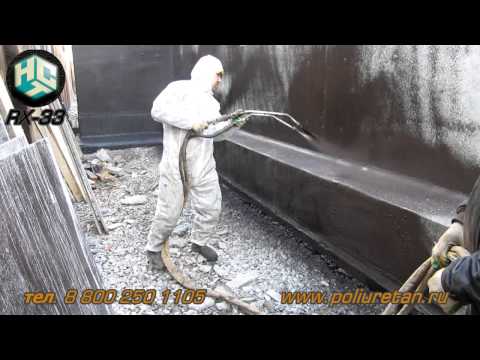
Penetrating insulation allows you to contain the impact on concrete of such factors as:
The high content of chlorine in water, which destroys the metal parts of the concrete structure and corrodes the metal,
Frequent wetting of a structure located on the street, exposure to concrete changes in the seasons, radiation during solar activity. Penetron, connecting with a concrete carrier, increases its density, which allows it to stoically resist the effects of aggression from nature.
The composition, when it hits the recesses and small cracks, filling them, produces a process of overgrowing, that is, they are drawn in by the mixture and completely disappear.
How to work with a mixture of Penetron
![]()

Application building mix involves diluting it with water to the state of thick sour cream and applying it to a surface moistened with water in advance. You can spread the composition with a brush or roller. First, corners and places with grooves and cracks are processed. Then it is rolled over all the necessary part of the concrete.
When applied, the components of the creamy mixture penetrate into the thickness through the capillaries and recesses and clog them. When interacting with the concrete base, an impregnated crystalline crust is formed, which strengthens and makes the concrete durable. Crystals prevent the penetration of moisture, but freely pass air flows, which allows you to maintain a favorable atmosphere in buildings. Applied, the Penetron mixture can be used to treat external walls and in the middle of buildings, which will create a completely impenetrable protection.
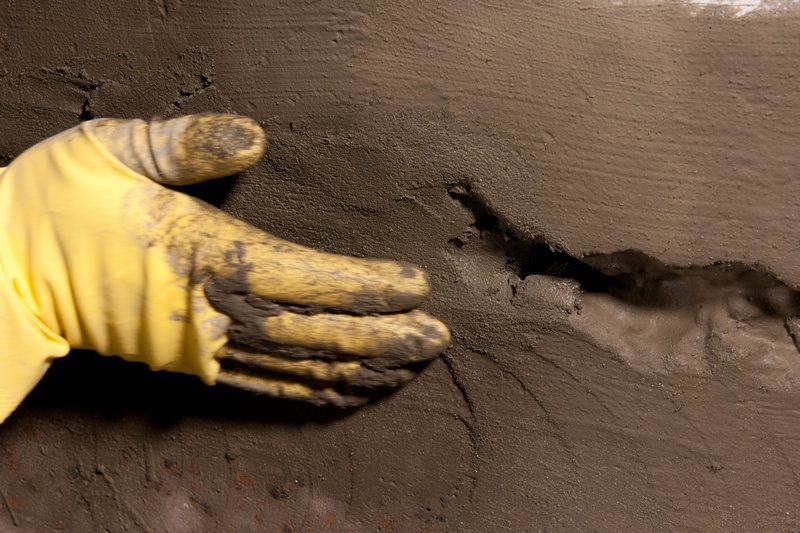
In other words, this is an effective composition that comprehensively treats concrete and, in the event of any damage and cracks, the mixture, using crystalline formations, tightens problem areas and the protection becomes complete again.
Liquid waterproofing method
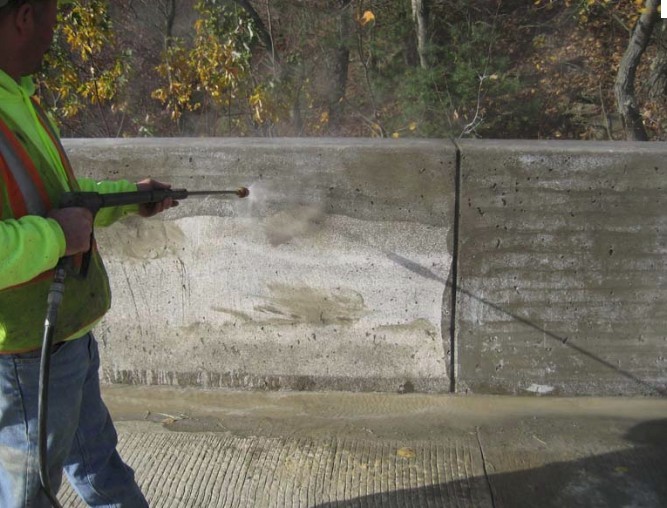
Liquid concrete waterproofing is the next processing method. The adhesion of every millimeter is important point. Otherwise, what is the use of processing if it is not stuck on the entire surface and will have gaps.

This occurs when applying rolled hydraulic insulators, through which air penetrates in some places, followed by water.
The complexity of processing a concrete base is that it is difficult to make it even and rough, wavy surfaces do not allow for good hydraulic insulation. This is where the method comes to the rescue, in which full coverage is made and the impossibility of passes arises. Liquid rubber will cover the entire surface, both before leveling and after it.

To apply liquid hydraulic insulation to the floor, a preliminary screed is made, but only in order to save material. But in those cases when it is necessary to make hydraulic insulation inside the concrete, that is, to make it and fill and screed from above, liquid rubber is just what is needed.
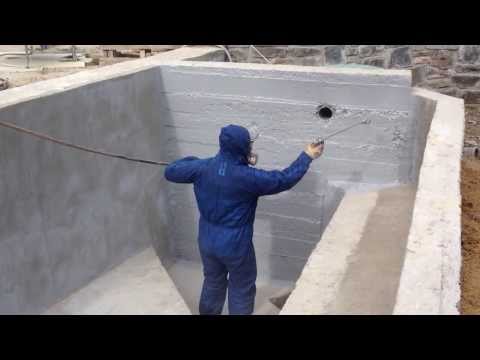
The more curved the surface, the more difficult it is to make a complete hydraulic seal, but this does not apply to the composition. liquid rubber, it freely covers up all the errors of the structure.
Another important fact is that liquid rubber can be applied to a layer of concrete that is not completely dry. That is, the applied rubber composition on concrete base, which was poured five days ago, will waterproof it and will not lag behind anywhere, and hydraulic protection can be made on the floor part already on the third day after pouring.

Bituminous and other insulators work only on a dried and cleanly cleaned substrate. Before applying, you need to check that there are no puddles left on the base, they are not visible to the eye, so you can run your hand and see if it is dry or not. If there are places where the hand feels a little moisture, you need to dry these areas. How to dry, you can get wet with a piece of foam rubber. If the hand does not feel moisture, and the surface is cold and slightly damp, you can spray rubber protection.
Rubber makes a complete seamless spacesuit over the entire surface. That is, when coated, there is not even a hint of any connecting overlap. There is a complete steam and hydraulic isolation. It turns out that the area treated with rubber is wrapped around from all sides. Excellent protection against moisture and gaseous substances.
Benefits of liquid rubber
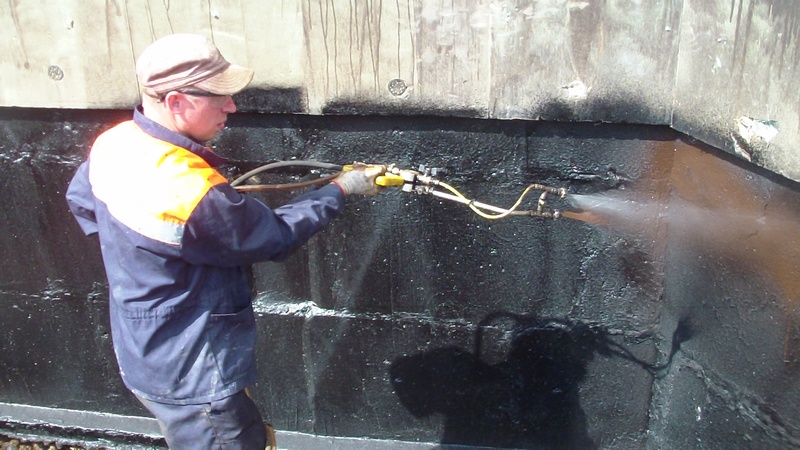
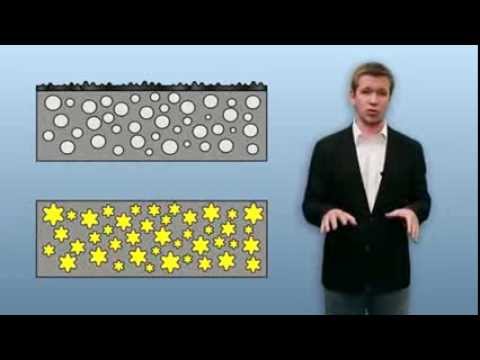

Formaldehyde, causes minor damage:
- Hydrochloric acid, harms only at high temperatures,
- Hydrogen sulfide does not cause any harm.
Liquid rubber keeps concrete bases from water and chemicals, but does not keep from mechanical breaks. Therefore, usually a screed is made on top of the applied composition, if it is a floor, and a coating of other materials is applied to the sidewalls.
Waterproofing materials
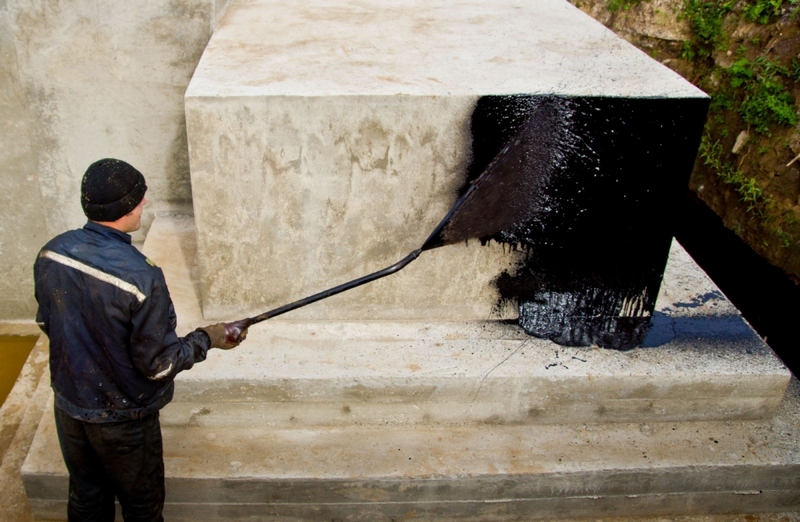
If it is necessary to hydraulically isolate the concrete foundation slabs from the outside, then in order to prevent damage, foam or insulation is placed on top of the rubberized base, and this is how the backfill is made.
When waterproofing concrete, various materials are offered, consisting of mastics containing bitumen and polymers. Technoprok produces environmentally friendly and high quality mastic for insulating concrete surfaces.

Do-it-yourself concrete waterproofing can be done with Rapidflex and Technoprok liquid rubber brands. These are emulsion compounds that can be used to process basements and other concrete premises on their own, but using equipment adapted for this. Rubber compounds are not applied with brushes and rollers, they must be sprayed onto the surface so that the liquid is evenly distributed and adheres.
Protective work for concrete structures is simply necessary, whatever the concrete, with correct proportions kneading, with the addition of an additive to concrete for waterproofing, using a variety of additives, without an additional protective film, it will begin to deteriorate and collapse over time. Corrosive processes occur, but if you carry out additional work in terms of protection from them, concrete can serve for a long time.

Concrete buildings built by the ancient Romans have survived to this day, but, of course, now no one plans to build such durable buildings, but for 50-70 years you can keep the foundation in good condition.
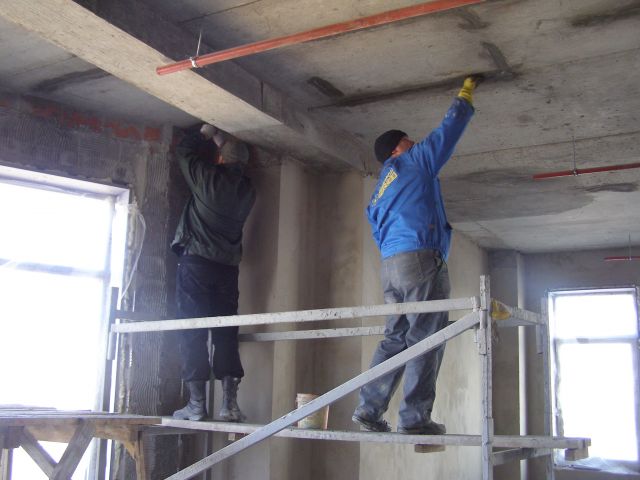
When processing and hydraulic isolation in own houses special compounds should be used to close all kinds of cracks and treat corners. Mastic for waterproofing concrete will close access to moisture through small cracks formed during drying. The entire surface is treated with it before applying any type of hydraulic insulation, except for penetrating and using liquid glass. In all other ways, it will help improve the water-repellent work of hydraulic insulation, fill and level construction errors and prevent the concrete base from starting to collapse at joints and chips.
Liquid glass for waterproofing

There are several options for hydraulic isolation, which are used for work on large construction sites and for water protection of domestic buildings. Waterproofing concrete with liquid glass is one of the options. At home, it is used quite rarely, since the composition has the ability to quickly crystallize and solidify. Of course, sometimes when building pits for storing water supplies, liquid glass in a powdered state is added to the mixed concrete, before it is poured into the prepared and installed formwork. It is quickly stirred, and the composition is compacted in the formwork.

Such an additive allows for a long time to maintain the integrity of the concrete and prevent water from flowing out. In addition, the added powder protects against the appearance of cracks through which water will seep, but such a pit is short-lived and will eventually have to be further isolated.
Construction crews use glass additives when kneading in special equipment, which makes it possible to prevent glass from crystallizing ahead of time and the prepared concrete will be more durable. There are also options for applying glass to the surface. There is sodium glass, which has increased stickiness and interacts well with mineral components. This category is used for additives in the foundation and in the manufacture of antiseptic and fire-resistant impregnations.

Potassium liquid glass is resistant to the effects of the atmosphere and is used in the manufacture of dyes. Liquid glass treatment is often used to protect architectural monuments made of concrete, since the applied glass covers the entire surface with a continuous crystalline film and water with the wind will not be able to destroy the statues. It is also used in places where a fire hazardous situation may occur, and glass, unlike rubber, will not burn and retain a protective layer.

When adding liquid glass to concrete solutions, precautions must be taken. So that the concrete is not spoiled, a quick kneading and rolling or pouring the finished solution is necessary. Before adding liquid glass is diluted in a ratio of 1:2 with water. It can be added to the solution and simply sprayed from the spray bottle onto the surface. A layer of liquid glass will restore the weathered areas of the concrete base and create antiseptic protection.
Description of the work process
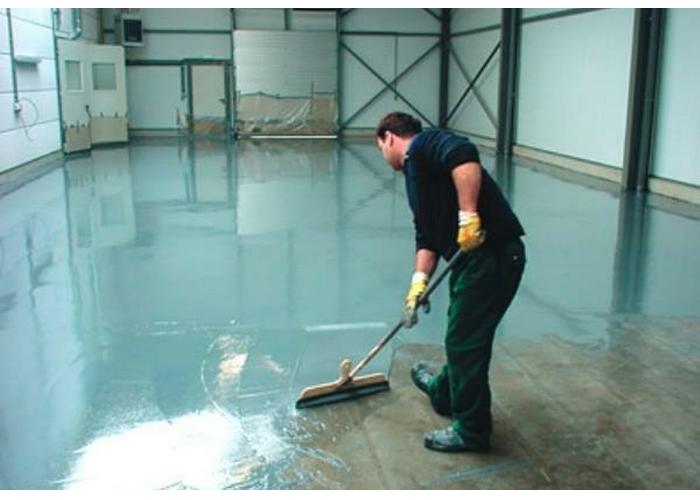
Before use, the entire surface is cleaned of dust, leveled and treated with degreasing compounds. For application to the surface, a spray gun is used, while the penetration of glass into concrete occurs by 1-2 mm. If it is necessary to increase the protective layer, then it is necessary to apply several times, thus increasing the penetration to 2 cm.

When processing wooden products, you can place it in a vessel with liquid glass for complete coverage and impregnation. For basements, 1 liter of glass can be added to the plaster for every 10 liters of mortar. Liquid glass used for hydraulic isolation of basements, screeds, wells and other buildings, as well as anti-corrosion protection of metal. Wooden floors are cleaned before treatment with liquid glass sandpaper. Before starting work, all surfaces are well cleaned.

There are several compositions that are used for hydraulic insulation. Now developed those that do not have a quick drying and can be used at home without the use of special equipment. These compounds are diluted with water in a ratio of 1: 2 and applied with a brush on a concrete base. The process is the same as for painting. The composition of the glass has such a feature that if the surface was not quite even, then the use of the composition will even it out, the roughness will be removed and small cracks will close.
The use of a new composition of liquid glass makes it possible at home to make a quick hydraulic protection of basements, bathrooms, wooden buildings, concrete sewer drains and wells.
- high water repellency
- high penetrating power
- prevents surface dirt retention
- prevents the formation of efflorescence
- frost resistance and crack resistance
- high moisture resistance and vapor permeability
Aquasol is a hydrophobic silicone liquid, water-repellent impregnation for the protection of stone, concrete and brick.
Aquasol- hydrophobic impregnation (moisture insulator) to impart water-repellent properties to various mineral surfaces.
It is a solution of modified polysiloxane resin in organic solvents with functional additives.
Silicone water repellent Aquasol It is used for independent protection against moisture and harmful atmospheric effects of any building materials based on cement: concrete and plaster, ceramic and silicate brick, composite facade tiles (stylized as brick and stone), aerated concrete and gas silicate blocks, natural and artificial stone(except gypsum products).
Or as a waterproofing hardening impregnation for paints and enamels on organic solvents.
Hydrophobic impregnation Aquasol has a high penetrating ability, significantly increases the strength, moisture resistance, frost resistance, corrosion resistance and crack resistance of building structures. Increases the overall thermal insulation properties of the structure, prevents surface contamination, does not change the appearance of the protected material and its vapor permeability.
Name | Price for 1kg | Price per container | ||
Aquasol 20l | 223 rub./1l | 4 460 rub./canister | ||
Aquasol- concrete water repellent (canister), 10l | 233 rub./1l | 2 330 rub./canister | ||
Aquasol- concrete water repellent (canister), 5l | 247 rub./1l | 1 235 rub./canister |
Consumption calculator
Video
Application
The penetration of moisture into the material, in the form of rain or snow, gradually leads to its destruction. Using a water repellent finish Aquasol(hydrophobization of concrete), significantly reduces the moisture absorption of the material, which can significantly extend the life of the structure and prevent the formation of efflorescence.
Surface treatment with water repellant Aquasol is a necessary measure for a wide variety of construction sectors and objects of various sizes: brick and concrete facades of buildings, plinths, fences, pillars, balconies, canopies, concrete floors, parapets, ebbs, slopes, paving slabs, tiled and slate roofs.
Coating based on hydrophobic impregnation Aquasol retains its protective and decorative properties, subject to the application technology, within 10 years.
Mode of application
Impregnation is ready for use, stir before application. The base must be dry, free of dirt, dust, grease, oils, residues of old coatings.
Application temperature: from +5 to +30°С.
Drying time at +20°C is 8 ocloc'k.
Consumption
Consumption of hydrophobic impregnation Aquasol- 150-250g/sq.m. depending on the type of surface.
Storage
Store in a tightly closed container, protected from heat and direct sunlight, at temperatures from 0 to +30°C. Guaranteed shelf life in the original packaging is 6 months from the date of manufacture.
Price
The cost of water-repellent impregnation - 223 rubles/1kg (20l), 233 rubles/1kg (10l) and 247 rubles/1kg (5l)
Tara
Container 5l, 10l, 20l. Attention! The label is equipped with anti-counterfeit security features.
Technical documentation
Certificate of state registrationState registration certificate (attachment)
Expert opinion, page 1
Expert opinion, page 2
Comments:
- The need for waterproofing
- Required accessories
- Additives for concrete
- Protection of concrete walls and facade coverings
Water-repellent impregnation for concrete can significantly increase its protection against water. After all, any construction material has a certain number of pores into which moisture seeks to penetrate. Concrete is no exception.
Water in the thickness of the material can cause a lot of trouble: lead to cracking, reduce thermal performance, etc. Water-repellent impregnation for concrete increases the durability of the entire building structure, which pays for the cost of its implementation.
The need for waterproofing

Concrete (even a non-porous structure) always has a small amount of microscopic pores and cracks. Water, seeping through the material, fills them. At sub-zero temperatures, water freezes, expanding by more than 10%, which can create an internal pressure of more than 200 MPa. This leads to new cracking and expansion of already existing defects.
Aggressive water impurities lead to corrosion destruction of the material, reacting with structural components. Corrosion of steel reinforcing elements proceeds especially significantly.
Water, penetrating concrete, leads to the formation of salt spots on the surface of structures - efflorescence, which spoil the appearance. In a humid environment, various microorganisms, mold, fungi feel good. Finally, moisture directly impairs thermal insulation characteristics concrete.
All this indicates the need to improve its waterproofing properties. This effect can be achieved if special additives are used in the solution at the stage of preparing the concrete mixture or by way of the construction stage or at the end of it.
Back to index
Required accessories
For work you will need the following inventory:

- container for the preparation of the composition;
- construction mixer;
- scales;
- paint roller;
- paint brush;
- staple;
- sandpaper;
- spray gun or spray gun;
- roulette.
Back to index
Additives for concrete
Hydrophobic additives for concrete are mixed with other ingredients during the preparation of the concrete mixture and enter the structure, providing water resistance. The most effective compositions are used for the foundation and in the construction of pools, water storage facilities, etc. The principle of their protective effect is based on the formation of a crystalline structure that prevents the penetration of moisture, for example, based on ettringite or silicates. High results are achieved when using Penetron ADMIX as an admixture for concrete. The more economical composition Crystal is used as a hydrophobic additive and anticorrosive protection of metal fittings; at the same time, it is able to raise the water resistance class of the material by 3-4 digits.

Mineral impregnation. Water-repellent impregnation of concrete is designed to protect the building structure after its formation. It penetrates the material to a certain depth and creates a barrier to water penetration. The impregnating composition may have a different basis and protection mechanism. Mineral impregnation, coming into contact with penetrating water, creates compounds that prevent the further passage of moisture. Such substances can also be used at the stage of mixing the concrete mixture.
Impregnation mortar Monolit-20M penetrates into the finished concrete structure to a depth of 25 mm, filling all pores and microcracks. The resulting gel seals the surface layer of the material, creating an obstacle that is insurmountable for water. Water-repellent impregnation for concrete such as Granite-28 or Aqua-Top forms a protective layer of calcium silicate on the surface, which not only increases the waterproofing properties, but also provides corrosion protection for reinforcement and mechanical strengthening of the surface layer of concrete. Such an outer layer achieves a compressive strength of 80 MPa.
Impregnation compositions based on organosilicon compounds are widely used. Such a substance, penetrating into the thickness of concrete to a depth of 20-25 mm, is evenly distributed throughout the volume and hardens according to the principle of polycondensation. A waterproofing layer is formed, as well as a barrier for efflorescence to go out; while the layer has vapor permeability.
Fungi or mold cannot form on the treated surface.
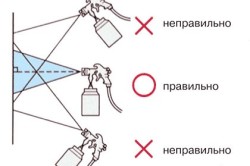
The standard organosilicon compounds Kristallizol and Monolit-Hydro proved to be quite reliable.
Silicone impregnating water repellent is a reliable protection against exposure natural conditions- snow, rain, frost. He penetrates deep concrete structure at a distance of about 6-8 mm, as a result of which a transparent protective film is formed on the surface, preventing the penetration of even the smallest particles of moisture into the pores and capillaries of the material.
With the introduction of water repellents into concrete, its thermal insulation properties are improved, frost resistance is increased. The impregnation components are not washed out of the base material for many years; they are colorless and will not affect the palette of facing coatings. Of the standard compositions, AVIS, Litos, Aquabarrier can be noted. For example, AVIS, penetrating into concrete, forms protective siloxane chains, which in turn form a siloxane lattice. Moisture cannot pass through such gratings.
